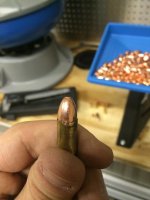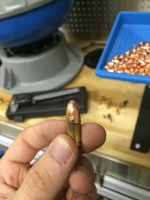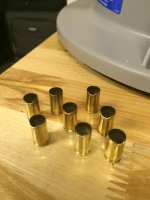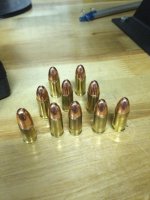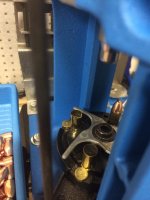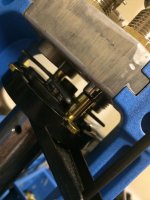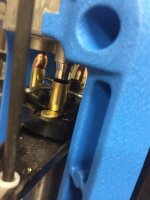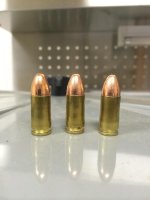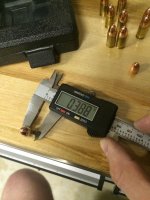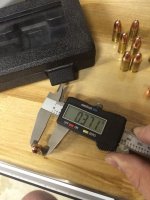tj1371x
US Veteran
So I just switched out caliber sets today from .38 to 9mm and I'm having an issue at the second station where the case bell is developed and the powder charge is dropped.
I was having about one out of every five bullets seat improperly, which I then realized came from chips in the case mouth at station 2.
View attachment 117520
View attachment 117521
View attachment 117522
View attachment 117523
View attachment 117524
I came to realize that about one out of every five or so casings aren't lining up properly with the powder drop at stage two, as depicted in these pictures where I stopped the lever upon meeting resistance:
View attachment 117525
View attachment 117526
I tried everything I could think of to remediate this problem with no luck. I re-calibrated the dies, I verified to make sure I changed out the caliber conversion plate and those little things that hold the cases against the plate. There seems to be a little bit of wiggle room for the casing to shake between these retaining screws and the plate edges. Not sure how that could be the cause, but I figured it was worth mentioning.
I'm using an assortment of brass, so I'm wondering if cartridge dimensions would be a factor? I didn't think it would be, but I'll ask the crowd here.
Also, on the cartridges that loaded fine, I was noticing that the middle of the cartridge seemed a bit thinner than the rest of the cartridge, like there was a bulge at the bottom of the case and also where the bullet was seated to. You can kind of make it out in this picture. I verified the difference with my caliper.
View attachment 117527
View attachment 117528
View attachment 117529
I referenced the manuals I have on hand (Speer and Lyman's), but couldn't find anything that referenced these problems. I also checked my Dillon manual for the 550, and couldn't find anything. I have a new Dan Wesson Pointman 9 coming in that I'm loading for, and I don't want to use these loads if there's anything unsafe about them. They were loaded using CCI 500 primers, assorted 9mm brass, 3.9 grains of bullseye (starting charge is 3.8-3.9), 124gr Berry's TMJ, and the OAL was 1.145. These were previously loaded and fired from either my Glock 19 or 26, and I've heard about case bulging being an issue with some Glocks due to lack of chamber support? Heard about this mostly for the Glock 20 regarding hot 10mm hand loads, but not sure if that would apply to 9mm Glocks that aren't loaded very hot at all (mouse fart ammo honestly). I remember the ejection patterns being pretty weak.
It's my first year reloading so I'm asking for any advice or help anyone can offer me on this. Obviously I'm not to experienced. Thanks if you've read this far an can offer up any solutions!
Sent from my iPhone using Tapatalk
I was having about one out of every five bullets seat improperly, which I then realized came from chips in the case mouth at station 2.
View attachment 117520
View attachment 117521
View attachment 117522
View attachment 117523
View attachment 117524
I came to realize that about one out of every five or so casings aren't lining up properly with the powder drop at stage two, as depicted in these pictures where I stopped the lever upon meeting resistance:
View attachment 117525
View attachment 117526
I tried everything I could think of to remediate this problem with no luck. I re-calibrated the dies, I verified to make sure I changed out the caliber conversion plate and those little things that hold the cases against the plate. There seems to be a little bit of wiggle room for the casing to shake between these retaining screws and the plate edges. Not sure how that could be the cause, but I figured it was worth mentioning.
I'm using an assortment of brass, so I'm wondering if cartridge dimensions would be a factor? I didn't think it would be, but I'll ask the crowd here.
Also, on the cartridges that loaded fine, I was noticing that the middle of the cartridge seemed a bit thinner than the rest of the cartridge, like there was a bulge at the bottom of the case and also where the bullet was seated to. You can kind of make it out in this picture. I verified the difference with my caliper.
View attachment 117527
View attachment 117528
View attachment 117529
I referenced the manuals I have on hand (Speer and Lyman's), but couldn't find anything that referenced these problems. I also checked my Dillon manual for the 550, and couldn't find anything. I have a new Dan Wesson Pointman 9 coming in that I'm loading for, and I don't want to use these loads if there's anything unsafe about them. They were loaded using CCI 500 primers, assorted 9mm brass, 3.9 grains of bullseye (starting charge is 3.8-3.9), 124gr Berry's TMJ, and the OAL was 1.145. These were previously loaded and fired from either my Glock 19 or 26, and I've heard about case bulging being an issue with some Glocks due to lack of chamber support? Heard about this mostly for the Glock 20 regarding hot 10mm hand loads, but not sure if that would apply to 9mm Glocks that aren't loaded very hot at all (mouse fart ammo honestly). I remember the ejection patterns being pretty weak.
It's my first year reloading so I'm asking for any advice or help anyone can offer me on this. Obviously I'm not to experienced. Thanks if you've read this far an can offer up any solutions!
Sent from my iPhone using Tapatalk

